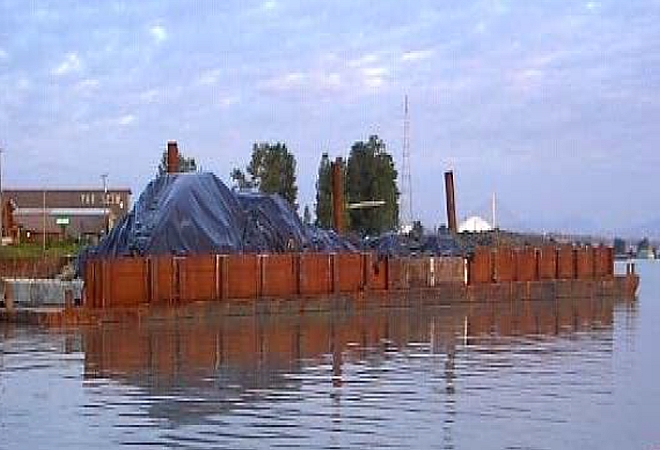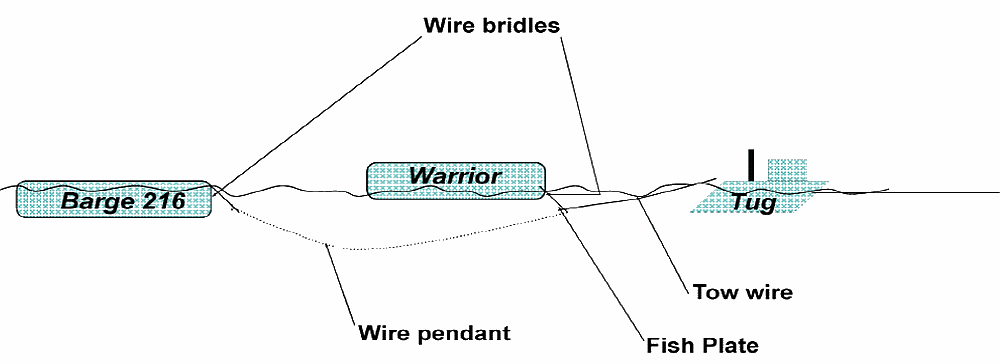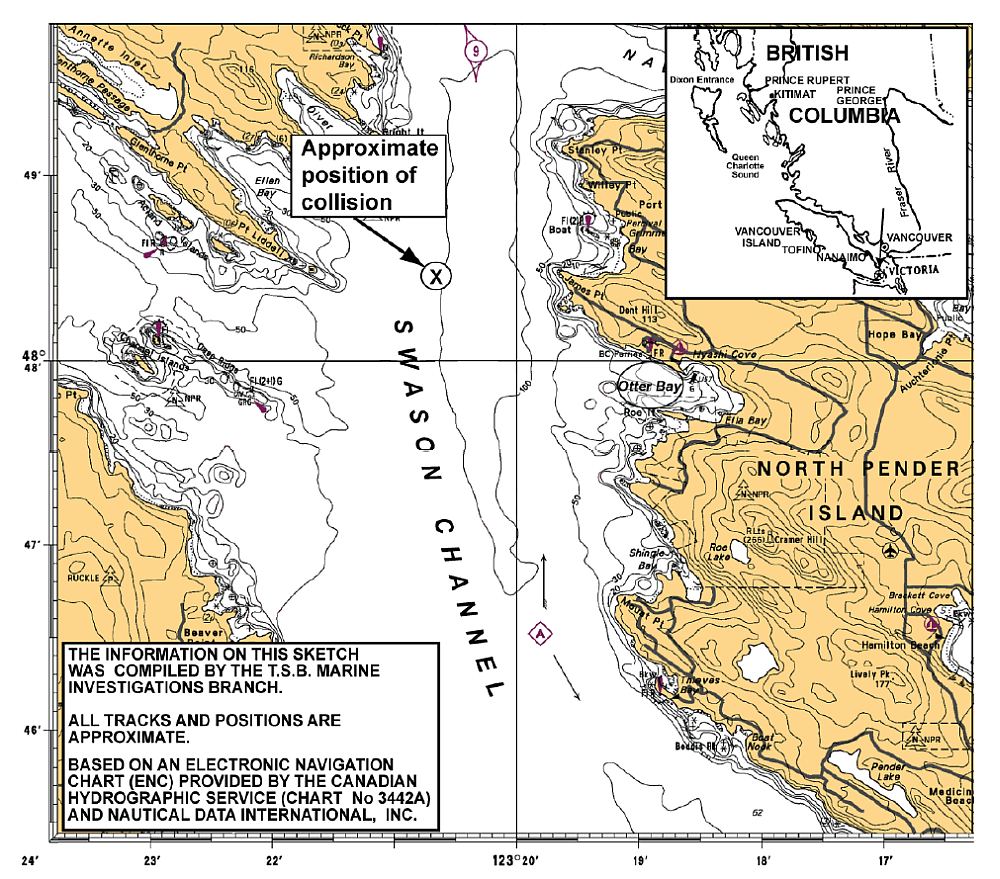Collision
Between the fishing vessel Sandra Carol and
The tug Ocean Warrior towing the barges Warrior and Barge 216
Swanson Channel, British Columbia
The Transportation Safety Board of Canada (TSB) investigated this occurrence for the purpose of advancing transportation safety. It is not the function of the Board to assign fault or determine civil or criminal liability. This report is not created for use in the context of legal, disciplinary or other proceedings. See Ownership and use of content. Masculine pronouns and position titles may be used to signify all genders to comply with the Canadian Transportation Accident Investigation and Safety Board Act (S.C. 1989, c. 3).
Summary
On the night of 03 June 2005, the wood-hulled fishing vessel Sandra Carol, with one person on board, was southbound in Swanson Channel en route to Victoria, British Columbia, when it became fouled on the steel wire towline connecting the barges Warrior and Barge 216. These barges were being towed northward by the tug Ocean Warrior. Unable to get clear of the towline, the fishing vessel was struck and holed by Barge 216. The Sandra Carol rapidly filled with water as its operator stepped from the deck of his vessel to that of the second barge without injury. The Sandra Carol sank approximately one hour after the collision.
Factual information
Particulars of the vessels
| Name of vessel | "SANDRA CAROL" | "OCEAN WARRIOR" | "WARRIOR" | "BARGE 216" |
|---|---|---|---|---|
| Official number | 174047 | 313909 | 800199 | 820969 |
| Port of registry | Port AlberniFootnote 1 | Vancouver | Vancouver | Vancouver |
| Flag | Canada | Canada | Canada | Canada |
| Type | Commercial fishing | Coastal tug | Non-self-propelled barge | Non-self-propelled barge |
| Gross tonnage | 23.0 | 76.31 | 2683.5 | 1024.0 |
| Length | 12.7 m | 18.8 m | 59.7 m | 58.5 m |
| Draught | 1.9 m | 2.8 m | 4.9 m | 3.7 m |
| Year built | 1945 | 1961 | 1981 | 1970 |
| Hull material | Wood | Welded steel | Welded steel | Welded steel |
| Propulsion | One 160-horsepower diesel engine driving a single fixed-pitched propeller | One 600-horsepower diesel engine driving a single fixed-pitched propeller in a fixed Kort nozzle | N/A | N/A |
| Cargo | N/A | N/A | Empty | 2500 tons of contaminated soil |
| Crew | 1 | 4 | 0 | 0 |
| Owner | Private individual | Delta Dredging | Lafarge Canada | Delta Dredging |
Description of the vessels
Sandra Carol
The Sandra Carol was a small fishing vessel of closed construction, having a carvel-planked hull and canoe stern. The hull below the main deck was subdivided by transverse watertight bulkheads, enclosing (from forward) the crew accommodation space, engine room, an insulated fish hold with freezer equipment, and a lazarette.
The deckhouse contained the wheelhouse, the galley area, sleeping quarters, the engine-room entrance, and stairs leading up to the wheelhouse.
The wheelhouse was equipped with a centreline steering station fitted with an autopilot. The navigation and communication equipment included a magnetic compass, very high frequency (VHF) radiotelephone, radar, depth sounder, and navigational light controls. Adjacent to the steering station were port and starboard weathertight hinged doors, which provided access to the foredeck, while a port side door fitted into the after-transverse bulkhead provided access to the main working deck.
Ocean Warrior
The Ocean Warrior is a single-screw, steel-hulled tug used mainly for towing barges on Canada's west coast. A single deckhouse encloses the wheelhouse forward with a helm station on the centreline. Navigation and communication equipment includes a magnetic compass, two radars, an autopilot, a global positioning system (GPS) unit, and a VHF radiotelephone. Secondary steering and engine control stations are located on the boat deck atop the wheelhouse and at the exterior after bulkhead of the deckhouse on the starboard side. The after station is also equipped with an emergency towing winch release mechanism. A towing winch containing 700 m of 29 mm steel wire tow rope is located on the centreline aft.
Warrior
The Warrior is a flush-decked steel barge used for hauling aggregate between ports on the west coast of Canada and the United States. The hull is painted black, and the 5.5 m steel box walls are painted grey. The barge was empty of cargo and had about 4.6 m of freeboard.
Barge 216
Barge 216 is a flush-decked steel barge used for hauling aggregate between ports on Canada's west coast. The hull is painted black, and the 1.2 m steel box walls are composed of unpainted steel plate (see Photo 1).
History of the voyage
At about 1030 Pacific daylight timeFootnote 2 on 03 June 2005, the Sandra Carol, with the lone owner/operator on board, departed Courtenay in a light condition for a shipyard in Port Alberni by way of Victoria. The distance to Victoria is approximately 120 miles.
The tug Ocean Warrior departed Victoria Harbour with a crew of four at about 1515 the same day, towing the empty aggregate barge Warrior approximately 61 m astern and the barge Barge 216 fully loaded with approximately 2300 tons of contaminated soil approximately 45 m astern of the Warrior. (For towing arrangement see Figure 1.)
The tug and tow were bound for the Lafarge Canada cement plant on the Fraser River.
The Sandra Carol transited Dodd Narrows south of Nanaimo, entered Tricomali Channel, and continued southbound into Swanson Channel. The Ocean Warrior transited Haro Strait and was northbound in Swanson Channel, heading toward the north arm of the Fraser River.
The progress of both vessels was being monitored on radar by Marine Communications and Traffic Services (MCTS) Victoria. The Ocean Warrior had been participating fully with the Vessel Traffic Services (VTS) reporting system throughout the voyage, keeping MCTS Victoria advised of its progress on VHF channel 11. The Sandra Carol was not a participating vessel nor was it required to be by regulations.Footnote 3
At about 2230, the two vessels were approximately 3.1 miles apart on opposing headings in Swanson Channel. Neither was aware of the other's presence despite the fact that the tug, both barges, and the fishing vessel were displaying the appropriate navigation lights. The owner/operator of the Sandra Carol had set the autopilot on a southerly heading, and with the vessel travelling at about 7.5 knots, had placed the radar and VHF radiotelephone on standby mode. He exited the wheelhouse on to the main working deck. The skipper of the Ocean Warrior was alone in the wheelhouse with the vessel moving ahead at about 4 knots while on autopilot. No other traffic was reported in the area, and the radar and VHF radiotelephone were functioning. The sea was calm and visibility was good. Neither vessel maintained a proper lookout.
At 2244, the vessels were within seven cables of each other when MCTS Victoria informed the Ocean Warrior of the danger of an impending collision. MCTS also made an unsuccessful attempt to contact the Sandra Carol using the VHF radio. Having been informed, the tug's skipper identified the target by radar and initially judged it to be stationary and in no danger of colliding with either the tug or barges. About a minute later, the skipper of the tug observed a green sidelight of a vessel (later identified as the Sandra Carol) fine on the starboard bow and altered five degrees to port. Shortly thereafter, he watched the green sidelight pass along his starboard side at a distance of less than one cable. The tug's skipper did not use sound signals but did shine a searchlight on the barge Warrior to alert the fishing vessel.
At 2246, the Sandra Carol, in a position with James Point on North Pender Island bearing 065° True (T) at nine cables, continued on its preset course and passed between the stern of the Warrior and the bow of the loaded Barge 216. The forefoot of the wood fishing vessel struck the wire pennant near the bridle of Barge 216. The vessel's hull planks broke, seawater quickly flooded the hull, and the vessel became swamped. The freeboard of the fully loaded Barge 216 was about the same height as the main deck of the Sandra Carol, and the owner/operator was able to step without injury onto the foredeck of Barge 216.
At 2247, the skipper of the Ocean Warrior informed MCTS Victoria of the collision. In turn, MCTS Victoria contacted Joint Rescue Coordination Centre (JRCC) Victoria. JRCC tasked the BC Ferries vessel Bowen Queen to render assistance. The ferry, which was close by, arrived on scene within 11 minutes. Meanwhile, two of the tug's crew launched a small boat to rescue the fishing vessel operator from the barge.
Approximately 30 minutes after the collision, the Canadian Coast Guard (CCG) vessel Skua arrived alongside the tug and transported the fishing vessel owner/operator to Ganges on Saltspring Island, where he was met by an ambulance, which transported him to the hospital on Gulf Islands. He was examined by hospital personnel and released within two hours.
The Sandra Carol remained fouled in the bridle of the barge for approximately one hour, after which it floated free, downflooded, and sank in approximately 70 m of water.
Geographical Information
Swanson Channel lies in a general north-south direction, passing between North Pender Island to the east and Prevost Island to the west (see Figure 2).
Weather and current information
The weather at the time of the collision was calm seas, clear skies, with visibility at least five miles. The wind was from the south at five knots.
Tidal streams in Swanson Channel are found in the Canadian Tide and Current Tables, Volume 5, and are referenced on Race Passage. They flood in a northwesterly direction and ebb to the southwest. The collision occurred approximately one hour before slack water ebb, at which time the current would have been negligible.
Damage to the vessel and environment
The Sandra Carol sustained extensive damage to the forward planking and sank. There was no damage to the Ocean Warrior or the barges. There was no appreciable amount of pollution as a result of this incident.
Vessel certification
Sandra Carol
Transport Canada (TC) inspected the Sandra Carol on 24 June 2003 and issued a full-term Safety Inspection Certificate (SIC 29) to operate on foreign-going voyages along the west coast of North America between the Panama Canal and Alaska until 30 January 2007.
Ocean Warrior
TC inspected the Ocean Warrior on 29 March 2003 and issued SIC 22 to operate on home-trade Class III voyages until 28 March 2007.
Personnel certification
The owner/operator of the fishing vessel did not hold any TC certification, nor was he required to do so by regulation. He had not undergone Marine Emergency Duties training. He had been a fisher for over 30 years.
The skipper of the Ocean Warrior holds a 350-ton certificate of competency and a First Mate, Intermediate Voyage certificate of competency issued by TC. He had also undergone Marine Emergency Duties training.
Crewing and safety
While the SIC 29 stipulated a crew of two, the Sandra Carol was operated by the lone owner/operator. He had been on continuous duty for over 12 hours. During this period, he was engaged in navigation-related activities as well as working on deck, and required the use of the washroom, leaving the wheelhouse unattended for periods of time. The vessel was transiting channels in coastal waters. He was unaware of the developing dangerous collision situation and was on deck at the time of the collision.
Findings
Findings as to causes and contributing factors
- The lone owner/operator of the Sandra Carol did not maintain a proper lookout and left the wheelhouse unattended with the radar and very high frequency radiotelephone on standby.
- The skipper of the Ocean Warrior did not maintain a proper lookout, nor did he use sound signals to alert the fishing vessel.
This report concludes the Transportation Safety Board's investigation into this occurrence. Consequently, the Board authorized the release of this report on .


